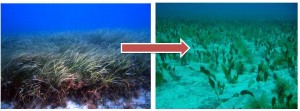We are all aware that seagrass meadows deliver essential functions and services to coastal ecosystems and human welfare. In many places of the globe, however, seagrasses have replaced by seaweeds. The implications of habitat shifts for ecosystem attributes and processes and the services they deliver remain poorly known. We have just published a paper comparing ecosystem structure and function between Cymodocea nodosa seagrass meadows and bottoms dominated by Caulerpa prolifera, a green, native, rhizophytic seaweed, through 5 ecological proxies: (i) primary production (via community metabolism), (ii) composition and abundance of epifauna (a proxy for provision of habitat for epifauna), composition and abundance of (iii) small-sized (juvenile) and (iv) large-sized (adult) fishes (proxies for provision of habitat for fishes), and (v) sediment retention (a proxy for sediment stabilization). Our results suggest that ecosystem structure and function differ if seagrasses are replaced by green rhizophytic seaweeds. Importantly, ecosystem functions may not be appropriate surrogates for one another. As a result, assessments of ecosystem services associated with ecosystem functions cannot be based on exclusively one service that is expected to benefit other services. The full reference is: F. Tuya, Png-Gonzalez, L., Riera, R., Haroun, R., Espino, F. 2014. Ecological structure and function differs between habitats dominated by seagrasses and green seaweeds. Marine Environmental Research 98: 1-13. Feel free to download the paper from the “articles” section of this blog.
-
Archives
- April 2015
- December 2014
- November 2014
- June 2014
- April 2014
- February 2014
- January 2014
- October 2013
- September 2013
- July 2013
- June 2013
- February 2013
- December 2012
- November 2012
- October 2012
- September 2012
- July 2012
- June 2012
- May 2012
- March 2012
- February 2012
- January 2012
- December 2011
- November 2011
- October 2011
- September 2011
- July 2011
- May 2011
- March 2011
- January 2011
- December 2010
- November 2010
-
Meta


